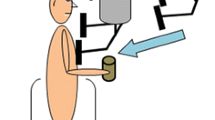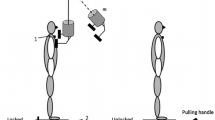Abstract
Postural adjustments associated with the task of raising oneself on tiptoes were investigated in a reaction time paradigm in six normal subjects and six patients with hemiparesis due to stroke. Body and ankle position in space were measured by means of a movement analysis system (ELITE). The findings indicate that the task of going up on tiptoes is performed in two steps. First, the centre of gravity is shifted forward to a position per pendicular to the forefoot. This movement is initiated by a phasic burst of EMG activity in the tibialis anterior (TA). The activity of the quadriceps femoris (QUA) aids the forward shift and together with the biceps femoris (BF) stabilizes the knee. Following these postural adjustments, the action of going up on tip-toes is performed mainly by the gastrocnemius medialis (MG). The basic pattern of preparatory (TA, QUA, BF) and focal (MG) activity was disturbed in its temporal sequence in patients with hemiparesis. The analysis of the biomechanical data showed smaller movement velocities for leaning forward and going up on tiptoes in patients, with increased duration of going up on tiptoes and decreased movement amplitude on the paretic side. In addition, the correlation between the start of horizontal (leaning forward) and vertical (going up on tiptoes) hip movement was lost in patients. The preserved correlation between the latency of MG activity and the onset of the vertical hip movement on the paretic side in patients and the loss of correlation on the non-paretic side indicates that the EMG activity on the healthy side is adapted to the functional requirements of the affected side. The findings demonstrate that preparatory and executional activity are not programmed as a unit, but are more likely to be generated by a hierachically organized structure using proprioceptive and exteroceptive feedback.
Similar content being viewed by others
References
Bazalgette D, Zattara M, Bathien N, Bouisset S, Rondot P (1986) Postural adjustments associated with rapid voluntary arm movements in patients with Parkinson's disease. Adv Neurol 45:371–374
Belen'kii VY, Gurfinkel VS, Pal'tsev YI (1967) Elements of control voluntary movements. Biophysics 12:134–141
Bouisset S, Zattara M (1981) A sequence of postural movements precedes voluntary movement. Neurosci Lett 22:263–270
Bouisset S, Zattara M (1983) Anticipatory postural movements related to a voluntary movement. In: Centre National D'Études Spatiales (ed) Space physiology. Cepadues, Toulouse, pp 137–141
Brown JE, Frank JS (1987) Influence of event anticipation on postural actions accompanying voluntary movement. Exp Brain Res 67:645–650
Cordo PJ, Nashner LM (1982) Properties of postural adjustments associated with rapid arm movement. J Neurophysiol 47:187–302
Dick JPR, Rothwell JC, Berardelli A, Thompson PD, Gioux M, Benecke R, Day BL, Marsden CB (1986) Associated postural adjustments in Parkinson's disease. J Neurol Neurosurg Psychiatry 49:1378–1385
Diener HC, Dichgans J, Guschlbauer B, Bacher M, Rapp H, Langenbach P (1990) Associated postural adjustments with body movement in normal subjects and patients with Parkinsonism and cerebellar disease. Rev Neurol (Paris) 146:555–563
Friedli WG, Hallett M, Simon SR (1984) Postural adjustments associated with rapid voluntary arm movements. I. Electromyographic data. J Neurol Neurosurg Psychiatry 47:611–622
Horak FB, Esselman PE, Anderson ME, Lynch MK (1984) The effects of movement velocity, mass displaced and task certainty on associated postural adjustments made by normal and hemiplegic individuals. J Neurol Neurosurg Psychiatry 47:1020–1028
Lee WA (1980) Anticipatory control of postural and task muscles during rapid arm flexion. J Mot Behav 12:185–196
Lee WA, Buchanan TS, Rogers MW (1987) Effects of arm acceleration and behavioural conditions on the organization of postural adjustments during arm flexion. Exp Brain Res 66:257–270
Lipshits MI, Mauritz K, Popov KE (1982) Quantitative analysis of anticipatory postural components of a complex voluntary movement. Fiziol Cheloveka 7:411–419
Massion J (1984) Postural changes accompanying voluntary movement. Normal and pathological aspects. Hum Neurobiol 2:261–267
Massion J (1991) Movement, posture and equilibrium: interaction and coordination. Prog Neurobiol 38:35–56
Thilmann AF, Fellows SJ (1991) The time-course of bilateral changes in the reflex excitability of relaxed triceps surae muscle in human hemiparetic spasticity. J Neurol 238:293–298
Zattara M, Bouisset S (1986) Etude chronometrique du programme posture-cinétique lié au movement volontaire. J Physiol (Paris) 81:14–16
Author information
Authors and Affiliations
Rights and permissions
About this article
Cite this article
Diener, H.C., Bacher, M., Guschlbauer, B. et al. The coordination of posture and voluntary movement in patients with hemiparesis. J Neurol 240, 161–167 (1993). https://doi.org/10.1007/BF00857522
Received:
Revised:
Accepted:
Issue Date:
DOI: https://doi.org/10.1007/BF00857522




